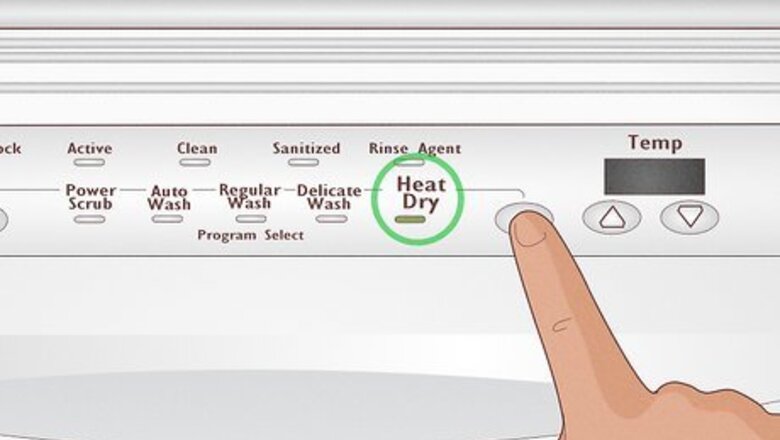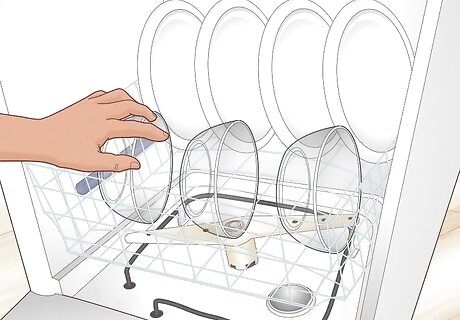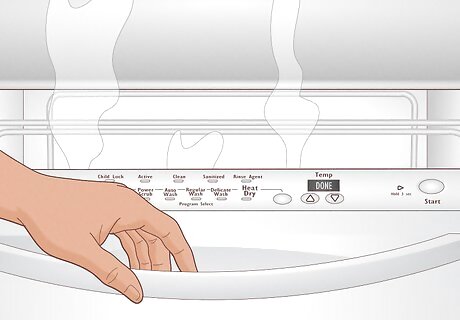
views
- Check your dishwasher settings and turn on a heated dry setting to make the water evaporate faster.
- Add more rinse aid solution to your dishwasher’s dispenser to help water run off your dishes more easily.
- Test your dishwasher’s heating element at the bottom of the appliance with a multimeter, and have it replaced if it doesn’t have an ohm reading.
Reasons Why Your Dishwasher Doesn’t Dry

The heated dry cycle is turned off. Many dishwashers have default settings for the air-dry cycle, but that can leave more water droplets behind on your dishes. When you’re about to run your dishwasher, double-check that you’ve selected the heat-dry or high-temp dry cycle to remove as much moisture as you can. Express cycles usually don’t use heat-drying to save more time, so they may leave your dishes wetter. Air-drying uses about 15% less energy than a heated dry cycle. If you don’t want to add onto your electric bill, then keep using air-dry and keep a towel handy when you unload your dishwasher.

The rinse aid solution is running low. Rinse aid solution mixes with the water inside of your dishwasher so it runs off of dishware more easily. Open your dishwasher and look for the rinse aid compartment next to where you place dish detergent. Unscrew the cap and pour in rinse aid until it reaches the fill line. Then, retighten the cap to secure it in place. Some rinse aid dispensers have adjustable levels to release more or less solution during a cycle. Increase the amount of rinse aid if you’re able to see if that helps your dishwasher dry dishes. If the dispenser is already full, then it may have buildup causing a clog somewhere along the line. Clean your dishwasher with vinegar by removing the dispenser cap, placing a small bowl of vinegar on the top rack, and running the hottest wash cycle.

The heating element is faulty. The heating element is the circular or square-shaped coil at the bottom of your dishwasher basin. First, inspect the coil for any obvious blistering or breaks that signal the part is broken. If there are no visual signs, then you may test the heating element with a multimeter set to read ohms. To test your heating element: Unplug your dishwasher and unscrew the kick plate panel on the bottom-front of the appliance. Locate the 2 vertical heating element terminals pegs with wires connected to them near the front of the machine. Slide the slipcovers off of the terminals and place 1 multimeter probe on each one. If the reading is between 0–50 ohms, then the heating element is working properly. If there is no reading, then hire a professional repair person to replace it for you. A new heating element typically costs around $30-40 USD for the part.

The high-limit thermostat is malfunctioning. The high-limit thermostat turns off the heating element before it overheats, but a broken one may prevent the element from starting at all. To check your dishwasher’s thermostat, unplug the appliance. Then, unscrew the bottom kick plate from the bottom-front of your dishwasher to access the components underneath. The thermostat is disc-shaped and connected to 2 wires. Reach under the center of the dishwasher and feel for a metal tab holding the thermostat in place, and press it down to release it. To test the thermostat: Disconnect the wires from the end of the thermostat. Use a multimeter set to ohms. Hold 1 probe against one of the thermostat terminals and press the second probe to the other. A good thermostat has a reading of 0 ohms at room temperature. Try holding the thermostat over a hot light for a minute and checking the reading again. If there’s no reading now, then the thermostat is working properly. If the reading has no reading at room temperature, then it’s time to replace the thermostat. Get a new thermostat and connect it to the wires on your dishwasher before reinstalling it.

The water temperature isn’t high enough. If the water going into your dishwasher isn’t hot enough, then it may not evaporate completely and leave your dishes wet. Let your faucet run with hot water for about 1 minute and then check the temperature coming from the tap with a thermometer. If the reading is below 120 °F (49 °C), then adjust your water heater to increase the temperature. Run your kitchen faucet on the hottest setting for about 1 minute before starting your dishwasher. That way, the water entering your dishwasher doesn’t have to warm up.

The dishwasher vent or fan motor is broken. The dishwasher vent is located at the top of the door and it helps release steam after the wash cycle so there’s not as much moisture. If the vent door gets stuck or if the fan’s motor blowing the steam through the vent isn’t working properly, then the water may stay on your dishes. If you notice any clogs in the vent cover grate on the inside of the door, clean it out with a flathead screwdriver or brush. If you feel confident taking apart your dishwasher, check the vent fan yourself by unplugging the dishwasher. Then, unscrew the screws on the inside edge of the door to slide off the door’s front panel. Locate the vent fan in the top left corner. Disconnect the wires on the vent fan and unscrew it to remove it.
Helping Dishes Get Dry

Load your dishes so they’re spaced out and don’t collect water. When you’re putting your dishes in your dishwasher, place cups, pots, and containers upside-down so water doesn’t collect or pool inside. Place plates in the bottom rack so they face the center and get the most clean. Make sure your dishes are spaced out so water can easily run off of them. Heating elements can melt or distort plastic, so place it on the top rack of your dishwasher.

Open your dishwasher door once the cycle ends. Once your dishwasher completely finishes running, pop open the door so some of the steam can escape. That way, the water doesn’t get trapped inside the appliance and stick to your dishes. Some dishwashers have settings that automatically open the door after the cycle ends. Check your dishwasher’s manual to see if there’s an automatic setting you can turn on.
How does a dishwasher dry dishes?

Older dishwashers have a heating element and fan to evaporate water. After the final rinse cycle, the heating element will turn on at the bottom of the machine. A fan blows the warm air throughout the machine so your dishes dry evenly. While heated drying is more effective for getting rid of moisture, it also uses a lot more energy.

New dishwashers use condensation drying to save energy. High-end dishwashers with stainless steel tubs have a final hot water rinse that warms up the dishes inside the machine. The water heats up your dishes, which causes the moisture to evaporate. When the steam touches the cold stainless steel walls, the water droplets stick and run out of the drain at the bottom. Plastic dishware doesn’t hold heat like glass or ceramic, so it may not dry well in your dishwasher even after making adjustments. Just use a towel to spot-dry plastic dishes if they’re still damp.


















Comments
0 comment